Introduction
Dominated by the great Thar Desert, the state of Rajasthan is a land of sand and rocks, parched farms and dusty grazing grounds. Its horizon outlines long plains occasionally punctuated by abrupt, rugged hills. These hills bear testimony to the land's martial history, for strewn along their crests are crumbling battlements and fortresses from which wars were won and lost over centuries of conflict.
Before 1947, the date of Indian independence from the British, what is now Rajasthan was a collection of kingdoms. While the rulers of these kingdoms had to defer to British judgment in matters political, they retained their authority in matters economic and social; categorized as princely states, the kingdoms were not subject to direct British rule. Most of Rajasthan's kings belonged to the Rajput caste, whose traditional duties are fighting and ruling.[1] The word Rajput means "son (putra ) of a king (raja )" and indicates the shared Rajput assumption that although not all caste members have been princes, all have descended from kings and so have inherited royal blood.
During a year and a half of fieldwork in Rajasthan, I studied the religious traditions of women belonging to this caste.[2] My purpose was to
[1] An exception is the ruler of Bharatpur, who belongs to the Jat caste. On the fluidity of Rajput caste identity and social mobility, see Dirk H. A. Kolff, "The Rajput of Ancient and Medieval North India: a warrior ascetic" (paper presented at the Conference on Preservation of the Environment and Culture in Rajasthan, Rajasthan University, Jaipur, India, December 1987).
[2] I performed this fieldwork in 1984–85 and returned for a few weeks in 1987–88 and again in 1989–90.
examine the ways in which Rajput devotional traditions reflect and influence relations between women's caste duties and gender roles. I wanted to understand how and when the foremost Rajput duty, the duty to protect a community, and the foremost female duty, the duty to protect a husband, take account of each other. Because throughout India and Indian history, Hindu tradition has articulated and sanctioned categories of caste and gender, I was interested in discovering the specific local sources of traditional authority governing the explicit and implicit decisions Rajput women make in interpreting, harmonizing, and reconciling caste and gender duties. My goals included understanding traditions Rajput women have inherited from the past and discovering if and how Rajput women have utilized and adapted past traditions to suit the contemporary circumstances facing the Rajput community.
To conduct this project I settled in at Udaipur, a small city in southwestern Rajasthan. Udaipur is the former capital of Mewar, a princely state whose royal line ranks first among the various royal households of Rajasthan.[3] Mewar gained this distinction as a result of the unceasing resistance it launched against Muslim invaders in pre-British days. Today Mewar retains the reputation of being the area of Rajasthan most resistant to social change.[4] The staunch conservatism of Udaipur's Rajput community shows in pronounced form a persistent tension between the Rajput desire to conserve tradition and the Rajput need to adapt to a changing world.
The tourist literature on the scattered sites important in Mewar history is filled with romantic testimonials to the courage and bravery of Mewar's Rajput soldiers. Not a few of these testimonials are cited from Colonel Tod's classic Annals and Antiquities of Rajasthan ,[5] one of the more famous British reports on Indian culture from the early nineteenth century. Captivated by Mewar's martial history, Tod devotes about as much attention to Mewar as he does to all the other Rajput kingdoms combined—a fact that irritates many non-Mewaris to this day. He enthusiastically recounts tales exemplifying chivalry, honor, fondness for
[3] For interesting observations on the Maharana's superior status in the 1940s, see Gayatri Devi's autobiography. Gayatri Devi and Santha Ram Rau, A Princess Remembers (Delhi: Vikas, 1984), 202–3.
[4] Among the scholars who have noted this characteristic are Susanne Hoeber Rudolph and Lloyd I. Rudolph, "Rajputana Under British Paramountcy," in Essays on Rajputana (Delhi: Concept Publishing, 1984), 15. Rajput residents of Udaipur, Jodhpur, and Jaipur also confirm it. As one Jaipur resident summed it up, "Udaipur is more backward than other places."
[5] James Tod, Annals and Antiquities of Rajasthan , 2 vols. (1829; reprint, Delhi: M. N. Publishers, 1978).
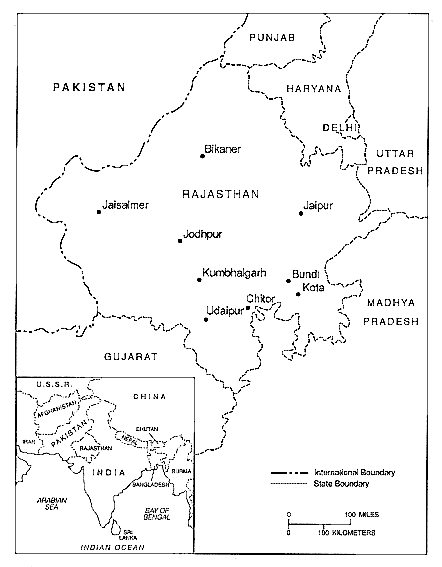
Rajasthan, with inset of Rajasthan in India.
opium, and weakness for women, traits he associates with Mewari Rajputs throughout their history.
Although sometimes disagreeing with Tod on the details of various battles or the subtler points of Rajput ritual and etiquette, the Mewari Rajputs I came to know readily refer to him as a masterful raconteur of their ancestral and cultural history.[6] Furthermore, while conceding that the circumstances in which Rajputs find themselves have changed dramatically, they believe that because they have inherited Rajput character, Tod's romantic depiction of Rajputs remains accurate. Keenly conscious and proud of their history, they want to preserve the values it exemplifies.
Mewar
Throughout Udaipur and its environs are symbols of the past that Rajputs find so inspirational. The most prominent buildings in Udaipur are the enormous City Palace, situated high atop the steep banks of Lake Pichola, and the Lake Palace, a fairy-tale-like marble pleasure palace at the lake's center (fig. 1). Owing a portion of its fame to the James Bond film Octopussy , which was shot there in the early 1980s, the Lake Palace is now a moderately popular tourist resort. Although the City Palace contains a luxurious hotel and a well-appointed museum, it continues to house some members of the royal family, who also inhabit other stately residences. While some of these structures have been converted to attract tourists to Udaipur, they remain symbols of Rajput history and identity. Members of the Rajput community speak with pride of the invitations they have received to socialize with members of the royal family in these places.
Just as the Udaipur palaces represent both the mores of the old order and the advent of modern business, so the physical layout of Udaipur symbolizes the juxtaposition of tradition and innovation. Around the City Palace is the old city, in whose narrow alleyways are located the urban residences of the noblemen who once attended the Mewar court. Outside this area in the newer part of the city are the government buildings and the bustling Bapu Bazaar, where consumers can purchase goods ranging from fashionable Bombay apparel to stainless steel kitchen appliances.
Mediating this contrast are the animals and the people who travel
[6] A town in modern Mewar is named after Tod. His work is available in English and Hindi.

1.
The Lake Palace, Udaipur.
from one part of the city to the other. In the old and new cities alike there are languid camels pulling carts, lines of burros transporting construction materials, cows napping, pariah dogs (all of which bear a strong family resemblance), and of course everywhere people, usually on foot, sometimes on bicycles or in horse carts, less often in auto rickshaws or motor scooters, and only occasionally in automobiles. Some of the men are dressed in western trousers; many others wear turbans and dhotis, long pieces of cloth wound about the waist, pulled between the legs, and tucked into the waist in back. Some of the women wear saris, long the fashion elsewhere in India but relatively recent arrivals in Rajasthan; others don varieties of traditional Rajasthani dress, consisting chiefly of bright blouses, tight vests, and long flowing skirts.
The roads winding through Udaipur trace the peripheries of three large lakes, in which cart ponies and water buffalo seek refuge from the relentless desert sunshine. Around the city rise steep rocky hills with jagged peaks. Deteriorating along their ridges are ancient city walls and royal hunting blinds, from which kings and noblemen once hunted all manner of game, including tigers and wild boar.
Beyond these walls lie the arid plains of Mewar, plains ill suited to agriculture. They are dotted nonetheless with tiny wheat and corn plots inevitably bordered by crooked cactus fences, beyond which graze goats
and sheep. Clustered nearby are little whitewashed houses. Most years the monsoon fails, and so the hot summer winds leave everything covered with thick yellow dust. During eight months of the year the daytime temperature often swells above a hundred degrees, which makes the water scarcity acutely troublesome.
Slicing through this barren landscape are a few single-lane highways, perhaps the most prominent signs of modernity. Along them travel trucks and buses, whose windshields are decorated with tinsel garlands draped over dashboard icons of Hindu deities. Once in a while an automobile speeds by, usually a taxi transporting tourists to such notable Mewar sites as Chitor and Kumbhalgarh, two of Mewar's former capitals (figs. 2, 3).[7] En route to anywhere are palaces and fortresses belonging to the erstwhile nobility. Those too expensive to maintain have been abandoned, but many are inhabited and remain the cultural focal point for residents of villages in which they are located and even for people in surrounding villages.
In sum, the juxtaposition of highway and fortress, trousers and dhotis, old and new, summarizes the transitional character of Mewari society. Trying to adapt to this changing world and yet conserve what they can of the old, Rajputs are particularly conscious of their status as Rajputs, as persons with royal blood. They cling to their sense of distinctiveness from members of other castes and maintain traditional status differentiations within their own caste community. They are distinctly aware of their "Rajputness."
Classes and Traditions
In Udaipur as elsewhere in Rajasthan, Rajputs understand themselves as belonging to one of three traditional classes. There are royal Rajputs, noble Rajputs, and ordinary Rajputs. The royal Rajputs ruled independent states, some of which, like Mewar, held vast territories. The heads of state were called maharajas (great kings), except for the Mewari ruler, who was styled maharana , meaning the same thing, this status distinction marking his superiority over the other independent rulers. These royal titles are still very much in use.
Serving the maharajas were noblemen, to this day called thakurs or sometimes rajas , both terms meaning "king." Their families lived on
[7] Spelling of Chitor varies widely on signs, maps, and texts; alternatives are Chittore, Chittor, Citaur, Chitaur.
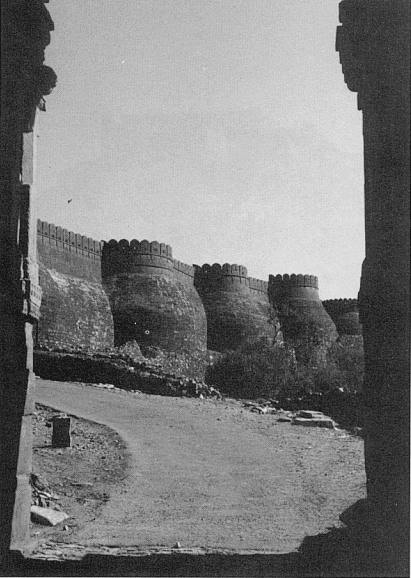
2.
Crenellated walls of the fortress at Kumbhalgarh, a former capital of Mewar.
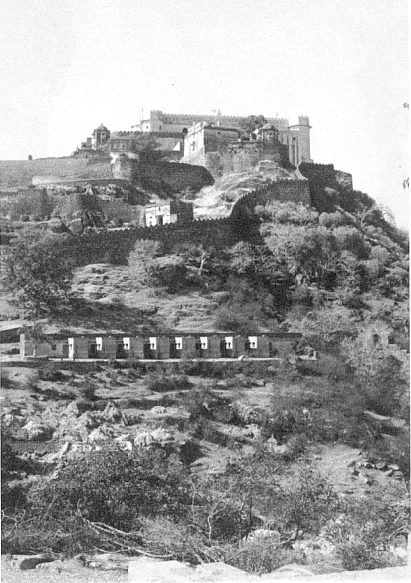
3.
The fortress at Kumbhalgarh; rugged Mewar terrain.
estates, thikanas , granted by the maharajas in return for military and administrative service. The thikanas consisted of a given number of villages, which the noblemen governed and taxed. When residing at their estates, the noblemen lived in palaces, which, if built in pre-British days, were usually protected by fortresses with tall crenellated walls. While attending their maharaja in his capital, however, they lived in rambling urban mansions (havelis ). Mewari noblemen spent up to six months a year living in their Udaipur households. Today, they remain distinctly aware of their privileged status as former advisors to the Maharana.
Finally, there are the ordinary, nonaristocratic Rajputs. While all Rajputs claim royal blood, some have been poor and powerless. The explanation all Rajputs give for this is primogeniture.[8] In traditional Rajput society the eldest son inherited his father's estate and title. Younger sons, potential threats to political stability, were encouraged to take their friends and followers, leave their brothers' kingdoms, and seek fortune by conquering their own lands or by entering into the service of a maharaja and winning from him a thikana grant. In turn, their younger sons set off to gain fortune and title; the prospects open to these second-generation younger sons were more limited than those that had been open to their fathers because they had fewer followers and other resources to take with them in their quests for power. Moreover, they had comparatively little to offer a maharaja in return for a thikana . Over a period of generations, youngest sons wound up with little or nothing at all and had to take up farming and living in small villages. These village Rajputs are referred to as "little brother" (chota bhai ) Rajputs.
Despite the class differences represented by these three groups, Rajputs maintain that they are all related to one another, however distantly, either by descent or marriage. They openly acknowledge that the genealogies of all real Rajputs intersect somewhere or other.[9] Moreover, they consider all Rajputs members of a single, if scattered, Rajput community. This community is the entire Rajput caste, or jati , within which their daughters must be married.
Given the many political and status levels of Rajput society, I won-
[8] Here as elsewhere my primary interest is not how things happened but how Rajputs understand them: not history, but its indigenous construction, grounds ethos. Doubtless primogeniture is partly responsible for creating chota bhai communities, but other factors, probably including upward caste mobility, enter the picture.
[9] The force of this qualification is that there are many whom members of the Rajput community regard as impersonators, lower-caste persons trying to infiltrate their ranks through marriage. They believe the community is and must remain constant; only its generations can and should change.
dered at first if it would be possible to discover any truly common Rajput tradition. As I learned more about the Rajputs, however, I found great continuity both of Rajput tradition and interpretation throughout the rungs of the Rajput hierarchy. In talking with men and interviewing women from royal, noble, and village households I found that Rajputs at each level identify the same traditions as important to Rajputs. Thus women from the three levels of society claim that all Rajput women must perform the same religious functions, chief among which are worshiping Rajput kuldevis (goddesses of the kul ) and venerating family sati s (women who have immolated themselves on their husbands' funeral pyres).[10] As I grew familiar with these traditions, it struck me that women narrating kuldevi and sati stories often contextualized their stories by referring to well-known stories of Rajput heroines. Within a few weeks of my arrival in Udaipur, I had learned many legends about the various heroines admired throughout Rajput society. All Rajput women knew these legends, though village women were often less clear on the historical details of these stories than noble and royal women. Because the Rajputs I met quite consistently identified traditions of kuldevi s, sati s, and ancestral heroines (virangana s) as the ones most important to Rajput women, and because the traditions provide several points of access to the ethos of Rajput women, I have organized my investigation into caste duty and gender roles around analysis of these traditions.[11]
Although the reasons for the importance of these traditions will emerge in the chapters following, a few preliminary remarks about them are in order. As concerning kuldevi worship, it is important to note that the literature on Rajput tradition, by no measure vast, has paid scant attention to the Rajput kuldevi . Though a number of prominent authors, some whose work I draw on, have analyzed the Rajput kul as a kinship unit, no author has devoted serious study to the kuldevi , who is the primary recipient of Rajput devotion and the primary emblem of Rajput identity.
There is scholarship (some of it quite recent) that treats apparently similar deities, including non-Rajput kuldevi s, who are worshiped by groups in various parts of India. It can be roughly divided into four categories: one comprising studies of deities, who are associated with
[10] A kul is a kinship segmentation unit that I discuss in the following chapters.
[11] I shall use other devotional traditions, especially those important to men, as context for these traditions. My ongoing book-length study of hero veneration treats many of these more fully.
one or more groups;[12] another comprising studies of villages or regions, some of whose deities are said to be connected with a group or groups;[13] a third comprising studies of kingship, in which the legitimating aspect of deity worship is explored;[14] and a fourth comprising studies of folklore, in which deities and their communities are analyzed in passing.[15] Authors often refer to such deities as "tutelary deities" but give little explanation for why a deity is in fact a tutelary deity or how a tutelary deity differs from other deities. In most cases, providing such an explanation would require authors to digress substantially from the concerns that they explore. Thus they use the phrase as a rather imprecise convenience that refers to no indigenous category of divine protector. They posit a special relationship between a given deity and a particular group or groups but neither explore the nature of that relationship nor analyze it with reference to relationships between other tutelary deities and their affiliated groups.
The term "lineage deity" is somewhat more precise in that it specifies a kinship relationship but often does not specify the extent or nature of a "lineage," which might be a small or an extensive segmentary kinship unit. Scholars use the word to refer to very different levels of kinship organization and identity.[16]
When scholars do use the indigenous terms kuldevi or kuldevta (kul deity), they still face the matter of definition, for the term's meaning
[12] Examples are Eveline Meyer, Ankalaparmecuvari (Stuttgart: Steiner Verlag, 1986); Gilles Tarabout, Sacrifier et donner à voir en pays Malabar (Paris: Ecole Française d'Extreme-Orient, 1986); Alf Hiltebeitel, The Cult of Draupadi , vol. 1 (Chicago: University of Chicago Press, 1988); William Harman, The Sacred Marriage of a Hindu Goddess (Bloomington: Indiana University Press, 1989); C. J. Fuller, Servants of the Goddess (Cambridge: Cambridge University Press, 1984); Gananath Obeyesekere, The Cult of the Goddess Pattini (Chicago: University of Chicago Press, 1984); Olivier Herrenschmidt, "Le sacrifice du buffle en Andhra cotier," Purusartha 5 (1981).
[13] See Marie-Louise Reinich, Les dieux et les hommes (Paris: Mouton, 1979); Nicholas Dirks, The Hollow Crown (Cambridge: Cambridge University Press, 1987); Lynn Bennett, Dangerous Wives and Sacred Sisters (New York: Columbia University Press, 1983); Gerald Berreman, Hindus of the Himalayas (Berkeley: University of California Press, 1972); and Edgar Thurstan, "Komati" entry in Castes and Tribes of Southern India (Madras: Government Press, 1909).
[14] For examples, articles from Purusartha 10 (1986) by Dennis Vidal ("Le puits et le sanctuaire"), Jean-Claude Galey ("Totalité et hiérarchie"), and Henri Stern ("Le temple d'Eklingji et le royaume du Mewar [Rajasthan]"); France Bhattacharya, "La déesse et le royaume," Purusartha 5 (1981); and Dirks, Hollow Crown .
[15] Examples are Velcheru Narayana Rao, "Epics and Ideologies," in Another Harmony , ed. Stuart H. Blackburn and A. K. Ramanujan (Berkeley: University of California Press, 1986); Brenda Beck, The Three Twins (Bloomington: Indiana University Press, 1982); and Gene H. Roghair, The Epic of Palnadu (Oxford: Clarendon Press, 1982).
[16] I first noted this variation during my frequent and often animated discussions with Veena Das at Amherst College in the spring of 1986.
varies from place to place and group to group. Thus with the borrowing of the word kul , we see that a divinity is conceptualized with reference to this particular kinship group. Often, however, the kul deity is not actually associated with a kinship group designated by the term kul . As we shall see, some Rajput kuldevi s are associated with kul s, and others are associated with smaller segmentary units. Elsewhere, deities deemed kul deities protect many different groups belonging to various kul s, sub-kul s, and castes.[17]
This study examines associations between kuldevi s—all Rajputs worship female, not male, kul deities—and their Rajput kinship groups. As it turns out, the notion conveyed by the term kuldevi is specific to the Rajasthani context. Understanding kuldevi tradition sheds abundant light on indigenous constructions of caste, kinship, and residency in Rajasthan; I believe that the same might well be true of kul deity traditions in other communities elsewhere in India.
Given the relative dearth of information on kul deities, it is perhaps not too surprising to find that no study has viewed kuldevi worship from the vantage point of women. In this study I show that Rajput men's and women's evaluations of the nature of kuldevi personality and of the meaning of kuldevi mythology vary dramatically. The sociological implications of this variance are important; focusing on kuldevi tradition reveals a number of crucial assumptions about the way women understand personal and familial obligations. For example, these assumptions challenge the traditional typification of North Indian wives as sociologically and religiously isolated from their natal religious traditions.[18]
As to sati s, I might mention that when I arrived in Rajasthan there existed no scholarly treatment of contemporary satimata veneration in this state. Those who had worked in Rajasthan had discussed the importance of commemorative sati stones and remarked that these monuments still play a part in the religious lives of some Rajasthanis.[19] No one, however, had investigated the tradition of veneration and discussed its paramount role in the religious lives of Rajputs today.[20] I was quite
[17] See Hiltebeitel, Cult of Draupadi ; Meyer, Ankalaparmecuvari ; and Roghair, Epic of Palnadu .
[18] Also challenging this assumption are two papers presented at the conference, Women's Rites, Women's Desires, Harvard University, April 1988: William Sax, "Village Daughter, Village Goddess," 17; and Lindsey Harlan, "Kuldevi Tradition among Rajput Women," 15. Also see Bennett, Dangerous Wives , 169; and William Sax's manuscript, Mountain Goddess (forthcoming from Oxford University Press), passim.
[19] See, for example, Ann Grodzins Gold, Fruitful Journeys (Berkeley: University of California Press, 1988).
[20] Paul Courtright is working on a largely historical manuscript that will incorporate some contemporary materials (The Goddess and the Dreadful Practice [forthcoming from Oxford University Press]).
honestly surprised to find that satimata veneration remains a thriving tradition, though the practice of self-immolation has become almost extinct.[21]
These days few people interested in India are unaware that sati veneration is a living tradition. Since September 1987, when the young Rajput woman Rup Kanwar joined her husband on his cremation pyre in a small village in eastern Rajasthan, the Indian papers and magazines have been full of articles and editorials on sati immolation.[22] The controversy sparked by the case has drawn international attention, including coverage by the New York Times .[23] It recounts the flocking of Rajasthanis to the cremation site, which, to the dismay and indeed the outrage of many, has become a place of pilgrimage. In the first month after Rup Kanwar's death alone over two hundred thousand people visited her newly built shrine to pay respects and receive her blessing.
The case has catalyzed impassioned debates, both national and local, about the necessity for discouraging self-immolation through prosecuting accomplices and forbidding institutionally sponsored sati glorification. The controversy has been accompanied by large demonstrations organized by those who denounce the practice (with some Indian feminists at the forefront) or by those who support it (with some conservative Rajputs at the forefront). In short, as I found out firsthand on a recent trip back to India, sati veneration has become a politically salient and emotionally charged issue.
Given this explosive atmosphere, it is particularly important to understand the tradition of sati veneration as it has existed within the Rajput community. Although I find the idea of self-immolation horrifying, my purpose here is not to evaluate the contemporary national controversy politically and ethically. That extremely important task, now being pursued so vigorously in India, is in many ways beyond the limited scope and design of this study and would require a large and disruptive digression.[24] Rather, my task here is to give the best description of the Rajput tradition of veneration that I can, having revealed the intellectual
[21] From literature and from discussions with ethnographers I conclude that Rajasthan retains the most widespread and thriving tradition of sati veneration in India.
[22] Examples of substantial press treatment include Rajni Bakshi, "Shame," Illustrated Weekly of India , 4 Oct. 1987; Inderjit Bhadvar, "Militant Defiance," India Today , 31 Oct. 1987; Manushi , special double issue, nos. 42–43, September–December 1987; Ashis Nandy, "The Human Factor," Illustrated Weekly of India , 17 Jan. 1988; Seminar 342, "Sati: a symposium on widow immolation and its social context" (February 1988).
[23] See Steven R. Weisman, "Indian Widow's Death at Pyre Creates Shrine," New York Times , 19 Sept. 1987.
[24] Because the Kanwar incident took place after my departure from India I have no systematic field research on local reactions to it. For a historical overview of sati immolation, see V. N. Datta, Sati (Delhi: Manohar, 1988).
interests and motivations that brought me to consider the topic in the first place.
By way of introducing the heroine stories to be analyzed in my final chapters, I should say that not nearly enough work has been done by way of analyzing how specific groups of people construe popular narratives that are part of their culture. Often researchers have gathered narratives without benefiting from the direct interpretive commentary that indigenous narrators can give them.[25] Because I was interested in the heroic stories as possible repositories of moral paradigms, I was keenly interested in voluntary exegesis.
One thing that surprised me in the course of interviewing was that when women listed their favorite heroines, they almost invariably insisted on telling the stories about these heroines in full, even if they knew that I had heard the stories many times. Clearly they thought that I could not possibly understand who a heroine was unless I understood crucial features of her behavior. These could only be pointed out properly in the context of storytelling. The evaluative glosses that women volunteered and of course the usually very subtle variations that they narrated gave me a rich source of information about women's values. Moreover, because the two stories that dominated women's responses, the stories of Mira and Padmini, radically conflict at one level in the values they espouse, only the interpretive and evaluative comments women made gradually enabled me to understand the broader, more encompassing normative ideals that the stories share. Furthermore, the Mira and Padmini stories have conveniently served to illustrate in narrative form some basic resolutions of normative dilemmas discussed in the kuldevi and sati chapters.
The Research Process
I realize that the nuts-and-bolts details of the research process do not hold equal fascination for all readers. For those curious about the specifics of the interviewing schedule I undertook, I have provided a detailed account in appendix A, as well as the interview format itself, in appendix B.[26] What follows here is a more general description of my
[25] An interesting exception is the new work by Linda Hess on oral Ramayan : "The Poet, the People, and the Western Scholar," Theatre Journal 40, no. 2 (May 1988): 236–53.
[26] I thank Alf Hiltebeitel and Tom Havens for the suggestion and acknowledge the agreeable example of this approach provided by Brenda Beck, Peasant Society in Konku (Vancouver: University of British Columbia Press, 1972).
fieldwork, including a brief characterization of the interview and its rationale.
For reasons to be divulged shortly, I chose to focus my work on the nobility, the middle rung of the Rajput class hierarchy. I did not feel I could generalize in any competent way, however, if I limited my interviews to members of this class. Without interviewing members of the royal and chota bhai (little brother) classes, I would be uncertain what information I received characterized only the nobility and what information pertained to all Rajput women. Thus for purposes of establishing boundaries and providing context I interviewed women from all three Rajput classes.
When I interviewed chota bhai Rajputs I did so in a small Rajput-dominated village forty minutes' drive northwest of Udaipur (fig. 4). All but two of the families in this rocky little hamlet trace their ancestry to the ruling family of Kelwa, an important estate several hours' drive north of Udaipur. The remaining families are connected historically to Delwara (fig. 5), another prominent Mewar estate. There was among villagers a consensus that the ones who really know the Rajput traditions, including the religious traditions, are the "high" (unce , referring to royal or noble) Rajputs. Village Rajputs felt that the aristocracy naturally and best performs, preserves, and understands the Rajput traditions (figs. 6, 7). They appeared convinced that preserving high Rajput tradition requires the kind of social education only the nobility has received and that the Rajput tradition preserved in the village is but a pale reflection of what goes on in the homes of higher persons. There is certainly some truth to this perception: although the villagers have a limited familiarity with traditions common to all Rajputs, the Rajput traditions they observe are heavily contextualized and influenced by local customs and lore.[27] Though I became intrigued with these local customs and lore, I decided to direct the focus of this particular study to the basic traditions that Rajputs generally share.[28] Following the villagers' advice I turned to the aristocracy and used my village notes only for contextual comparison.
[27] Gerald Berreman received similar advice from Himalayan villagers, who suggested he consult learned people instead of them (Berreman, Hindus of the Himalayas , 108).
[28] I intend to focus on the specific village synthesis in coming articles. With little information on other Rajput villages, I lack the comparative basis that I gained in studying aristocratic women. Some religious traditions are similar to those described in Gold (Fruitful Journeys ), but because the village I came to know is overwhelmingly Rajput, its kuldevi and sati traditions figure larger in village life than they do in Gold's case and in non-Rajput villages.
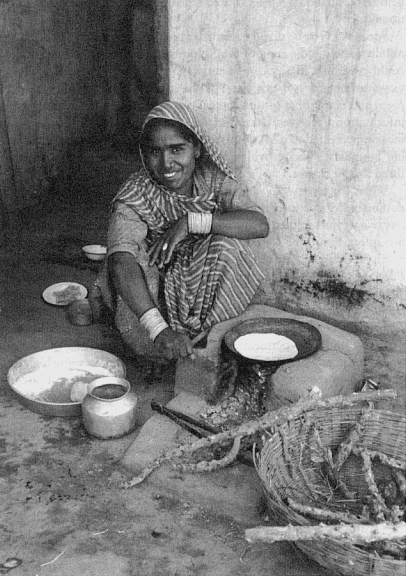
4.
Rajput village woman in her courtyard.
In my focus on the nobility I have sometimes included substantiating information gleaned from interviews with women from royal households, who were either native to or had been married in major Rajasthani kingdoms.[29] I encountered great continuity of knowledge and belief among noblewomen and royal women. One reason for this is that many royal wives are born in noble households. Another is that both noble persons and royal persons have patronized, articulated, and interpreted Rajput tradition. They have performed the same religious functions on parallel political levels.
I made my decision to concentrate on noblewomen instead of royal women for two reasons. First, quite simply, the nobility is larger than the royalty and therefore provides a better sample of experience. Second, on balance, noblewomen have preserved their traditions more completely than have the royal women, many of whom live in fairly modern urbanized settings and spend much of their time away from Rajasthan in Delhi, Bombay, and abroad.[30]
Most of the noblewomen I interviewed are from Udaipur, yet because I wanted to understand not just the traditions of Mewar but those shared by Rajputs as a whole, I combined my work in Mewar with multiple visits to Jodhpur (northwestern Rajasthan) and Jaipur (northeastern Rajasthan). In this way I was able to discover traditional patterns illustrated by Udaipur households that are common to all noble households throughout Rajasthan. Furthermore, such an approach also enabled me to discern pattern variations.
Finally, while I was in Udaipur I not only interviewed women living in urban residences (whether havelis or modern houses) but also traveled to various estates (thikanas ) whose fortresses or palaces were still occupied.[31] My purpose in visiting these places was to talk with women still living in estate households and to examine the division of traditional households into the zanana (female quarters) and mardana (male quarters).[32] Most urban households, even havelis , are no longer divided up
[29] These kingdoms include Jodhpur, Jaipur, Kota, Jhalawar, and Bikaner, as well as Udaipur. Among the noblewomen some have husbands from very small states that were technically independent. Many such states are actually smaller and less powerful than the major thinkanas attached to the large states; like them, these small states are aligned with and in many ways dependent on large neighboring states. The leaders of both often use the same titles (rana, rao sahib , etc.) and have similar status.
[30] This is a relative distinction. Many royal women are conversant with Rajput traditions. Some observe them and are quite religious; others have knowledge but say travel or other priorities often intrude on observance.
[31] These included Amet, Ghanerao, Bari Sadri, Bansi, and Kothariya, all prominent Mewar thikanas .
[32] In some of these estates elderly women still live in the zanana , whereas younger women go back and forth between the parts of the household. Unlike the crowded urban residences, the spacious estate palaces clearly show the delineation of male and female space.
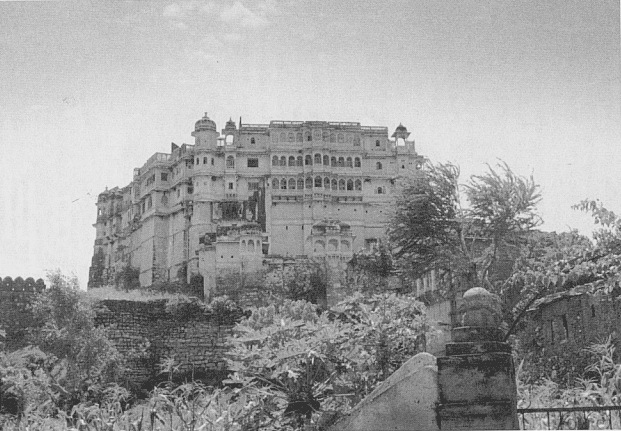
5.
Delwara: a Solah Thikana.
this way. By investigating and diagraming the temples and shrines in male and female space within estates, I learned much about the origins of differences between male and female devotional traditions.[33]
At the very start of my research among the nobility, the biggest problem I faced was that of access. One cannot simply call up a princess and ask to come over.[34] At first, those few Rajput noblewomen I met through acquaintances were cordial, but most did not want to be interviewed. Some eventually explained that Rajput women despise chattiness and consciously cultivate social reserve toward those people they consider outsiders. Reserve, I was gradually to learn, is greatly valued by Rajput women, who understand it as the sine qua non of dignity.
Thus my initial meetings with Rajput women were often characterized by almost excruciating formality. I sat in havelis or thikana forts sipping tea, conversing politely, meeting relatives, confronting curious children, usually to find that, alas, no time remained for discussing matters related to my research. Sometimes this was accidental; often it was not. Only after I had met many members of the community and been in Udaipur for months observing daily affairs, participating in festivals, visiting pilgrimage sites, and dropping by for cups of tea did I find that the atmosphere had relaxed enough for informal chatting and open questioning.
When at last I began to interview, a number of women expressed true surprise at the nature of my questions. "You mean you actually want to know about kuldevis !" one woman exclaimed. She admitted that she had been sure that I was not interested in women's religious traditions and that I was really in Udaipur to find out about Rajput family problems.[35] She said that she had initially dodged an interview because a Rajput woman must always save face: even though she has problems, she must not complain about them. This woman added that her suspicion had been shared by others who were hesitating to be in-
[33] Men have usually worshiped kuldevis in temples located in the mardana or outside the household, and women have worshiped them in small, sometimes crude, kuldevi shrines in the zanana . This segregation of tradition has engendered standard variations in interpretations of kuldevi tradition.
[34] The fact that many of those I interviewed lack phones turned out to be an advantage, as it made unannounced return visits possible.
[35] At first some women feared that my interest was male alcohol abuse and its associated family problems. While women uphold alcohol consumption as a Rajput prerogative, many worry about excesses in consumption, which they often attribute to depression over declining Rajput values and fortune.
terviewed.[36] Once my real purpose was clear, almost all the women relaxed and obviously enjoyed the interview. Many considered themselves very religious and found it pleasant to talk about religious matters.[37]
Interviews were generally done in Hindi. Women who speak English, however, sometimes preferred to do so during the interview or to go back and forth between the two languages, which I often found myself doing as well. I conducted one hundred and seven interviews, of which seventy-seven were with aristocratic women, eight with members of royalty, and twenty-two with villagers. The narratives that women provided during these interviews were generally concise stories, often best known and recited by older women. Many of these women were worried that younger women and their children were uninterested in their narratives and too interested in storybooks and, even worse, in television, which arrived in Udaipur shortly after I did.[38]
Though I am uncertain as to the extent to which storytelling is on the decline (it would be interesting to reinterview women in a number of years to see if they grow more or less conversant with narratives as they mature), I am impressed by the extent to which women of all ages overwhelmingly stress the importance of preserving parda , the seclusion of women within the household. Rajput women often say that the mark of a Rajput woman is her unwillingness to "go out." Most women in Udaipur stay inside; they do not worship in local temples, shop in markets, or even enter voting booths. Interestingly enough, this norm of seclusion has not made them ignorant of religious customs in other parts of Rajasthan and beyond. The women in an aristocratic Rajput household tend to come from a variety of regional and financial backgrounds. The interview results and indeed the general history of Rajput marriage alliances demonstrate that zanana s have always been more cosmopolitan than mardana s. Each Rajput family has daughters-in-law familiar with religious and mythical traditions from their natal homes. Hence although each family has its own traditions known to all members, the women of the family also have knowledge of traditions from
[36] Several women have confirmed the initial general suspicion of my motives, which in retrospect amuses them.
[37] Most women, however, as members of the nobility and public persons, did not want their names attached to the information and opinions they provided. Having promised to protect their anonymity, I have identified only those women who gave me permission.
[38] On recent social change in the Rajput community see Lindsey Harlan, "Social Change and Rajput Tradition" (paper presented at the Conference on Modern South Asian Religion, Social Science Research Council, Amherst College, August 1987).
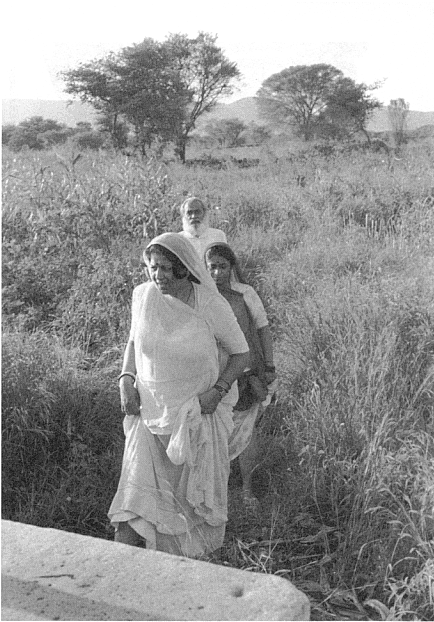
6.
Noblewomen approaching hero shrine at their thikana .
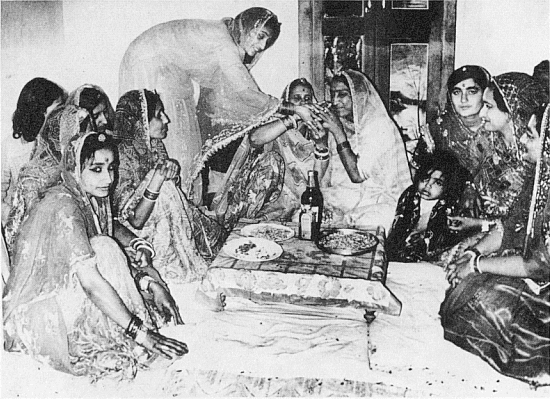
7.
Drinking ceremony in an aristocratic Rajput wedding (from the wedding album of a Mewari thakur ).
outside the family. Because of this, by talking to women of any major town, an interviewer can learn about traditions from all over Rajasthan.[39]
While every individual Rajput marriage introduces into a family a woman with a foreign background, on a macro level of analysis, intermarriage within the relatively small Rajput community tends to reinforce the same general norms throughout Rajasthan. Moreover, as mentioned above, while women bring in different traditions, they share the conviction that natal traditions should not subvert or supplant conjugal traditions.
A significant qualification to this point is that whereas Rajputs all over the state are aware of traditional Rajput norms and customs, those living in eastern Rajasthan, especially in or near Jaipur, have by and large taken up a more urbanized style of life than that still followed in the west. While the interview questions revealed attitudes shared by all Rajput women, the women I interviewed were largely those married into Mewari households. The results are therefore dominated by the experiences of women living in the conservative western part of the state.
Although the majority of information upon which I rely in this study comes from the interviews, I had other significant sources. Throughout my stay in Rajasthan, I made recurrent and often extended visits to urban and rural homes to chat informally and observe families in the midst of their daily routines. Many women from these homes graciously included me in family activities and social functions. Within this group were many noblewomen with whom I became sufficiently good friends to visit frequently, in fact even daily. They freely voiced their concerns about such matters as the cheapness of my jewelry and the ugliness of my freckles and sunglasses. From them I learned the intricacies of Rajput etiquette and protocol and also, little by little, the local gossip. At their homes I consumed countless quantities of tea and asked what I am sure amounts to thousands of questions, many of them surely annoying questions about details of ritual and etiquette. Two of these women invited me to stay at their thikana residences for extended visits. Although I visited many thikanas during my time in Rajasthan, my time in these old estates was particularly rich as it afforded many uninterrupted hours of discussion on religion and family history.
[39] In Rajasthan, as elsewhere in India, marriage is typically patrilocal; brides live with their husbands in extended families. Rajputs tend to marry across long distances. Although most Mewari brides come from other regions in Rajasthan, a few come from more distant places like Himachal Pradesh, Madya Pradesh, and Orissa.
I also spent a lot of time with two other women, Honey and Chotu, who were then unmarried women in their middle twenties. Having taken an interest in my research early on, they volunteered their help in many ways, including arranging introductions, filling me in on the latest happenings, and occasionally joining me on excursions. They frequently kept me company during the lonely and hot afternoon hours when the rest of Udaipur was napping.[40]
The other types of information upon which I relied were informal conversations with Rajput men (who were often interested in their ancestral history and willing to narrate parts of it they thought relevant to my interests), discussions with non-Rajputs from different caste backgrounds about their perceptions of Rajput women, many visits to shrines and pilgrimage places that Rajput women said were important to them, and later, brief informal follow-up interviews with fifty women to test tentative conclusions before I headed back to the United States.[41]
Throughout my stay in Rajasthan I felt there was always more to learn; rare was the day that was not filled with new discoveries. Because the religious tradition of the area has been understudied and thus underrepresented in the literature on India, I found much in my research that contradicted general assumptions I had assembled during my years of study. I was continuously challenged by puzzles demanding solutions. Some of the puzzles that intrigued me most I have attempted to work out in this book.
This puzzle-solving project begins in the next chapter, which characterizes the Rajput community as a whole and then focuses more narrowly on the separate world of women. Its survey of the social and religious beliefs, norms, and responsibilities of Rajput women serves as background for the investigation of caste and gender duties conducted in remaining chapters.
[40] These women were unusual. They were daughters in prominent and traditional families but worked together in an emporium managed by relatives. They explained that their families had allowed this work because they were unmarried and working with relatives. Now both have married and quit working outside the home. One married into a thikana near Jodhpur. The other moved to Kuwait with her new husband, who is from a prominent thikana in Gujarat, but then returned to Bombay during the airlift of Indian nationals after Iraq's invasion of Kuwait.
[41] The results of these interviews concerning possession and dream appearances quantitatively confirmed the information about appearances by supernatural beings contained in chapters 2 through 5.